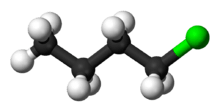1-Chlorobutane
 | |
| Names | |
|---|---|
| IUPAC name
1-chlorobutane, N-Butyl chloride | |
| Identifiers | |
3D model (JSmol) |
|
| ChEMBL | |
| ChemSpider | |
| ECHA InfoCard | 100.003.361 |
PubChem CID |
|
| UNII | |
| |
| |
| Properties | |
| C4H9Cl | |
| Molar mass | 92.57 g·mol−1 |
| Appearance | Colorless liquid[1] |
| Density | 0.89 g/mL |
| Melting point | −123.1 °C (−189.6 °F; 150.1 K)[1] |
| Boiling point | 78 °C (172 °F; 351 K)[1] |
| 0.5 g/L (20 °C)[1] | |
| Solubility | Miscible with methanol, ether |
| -67.10·10−6 cm3/mol | |
| Hazards | |
| Safety data sheet | Fischer MSDS |
EU classification (DSD) (outdated) |
Highly flammable |
| NFPA 704 | |
| Flash point | 17 °C (63 °F)[1] |
Except where otherwise noted, data are given for materials in their standard state (at 25 °C [77 °F], 100 kPa). | |
| Infobox references | |
1-Chlorobutane is an alkyl halide with the chemical formula C4H9Cl. It reacts with lithium metal to give n-butyllithium:[2]
- 2 Li + C4H9Cl → C4H9Li + LiCl
References
- 1 2 3 4 5 Record in the GESTIS Substance Database of the Institute for Occupational Safety and Health
- ↑ Brandsma, L.; Verkraijsse, H. D. (1987). Preparative Polar Organometallic Chemistry I. Berlin: Springer-Verlag. ISBN 3-540-16916-4.
This article is issued from
Wikipedia.
The text is licensed under Creative Commons - Attribution - Sharealike.
Additional terms may apply for the media files.
